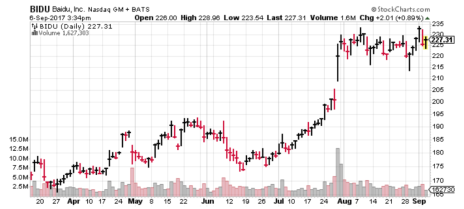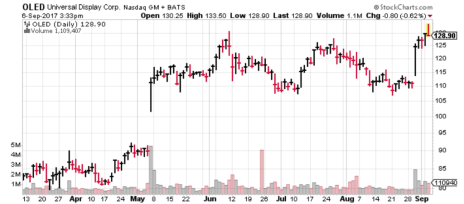The Difference Between the Market in 1999 and Today
Today, I want to tell you how to handle the best growth stocks in the market when they start to show signs of weakness. But first, I want talk about how much this market made me think of what it was like around the turn of the century.
When I first joined Cabot back in June of 1999, we were smack dab in the internet bubble. I was hired to help write a new advisory called Internet Stock of the Week, which did fantastically well until the bear market really got underway in earnest in September 2000.
As you can imagine, investor sentiment in the late 1990s was giddy, to say the least. Making 10% or 20% in a year wasn’t the goal; many investors wanted that in a quarter or even a month. Making 100% in a stock wasn’t considered a major success—500% to 900% was the real goal. Those were crazy times.
[text_ad use_post='129623']
I remember a couple of conversations I had with a subscriber in January 2000. The Nasdaq had a “small” correction during the month before its final blowoff phase, and we got stopped out of a super-hot biotech stock or two during the dip—right before biotechs took off into late-February (and crashed afterwards).
Anyway, the profits on these biotech trades were big—something like 75% to 100% if memory serves. But a couple of subscribers complained about how badly we sold and how we cost them $XX in their personal accounts.
I was thinking of those 17-year-old events recently when, during the August correction, most of the questions I received concerned whether readers should bail out of this or that stock. Of course, in many cases, these were fair questions; quite a few stocks did break their uptrends in recent weeks. I sold many stocks from Cabot Top Ten Trader as they tripped our stops.
But I would say at least half the questions I got concerned stocks that investors had good profits in and, to that point, had experienced normal pullbacks and consolidations during the summer. While the focus in 2000 (and at other market tops) was the “pain” that was felt by not continuing to let a winner run, today investors fear losing the profits they have, even if they’re relatively modest. It’s quite a change.
In fact, that difference in sentiment is one sign that we’re not yet at a market top. And it tells me that it would be wise to be a little less sensitive to corrections today.
Too much greed can clearly lead to bad outcomes, but today I think that most investors, scarred by the past two bear markets and (for many) at or near retirement age, have too little tolerance for drawdowns (pullbacks in stocks and the market).
Put simply: If you’re going to invest in the best growth stocks and make good money, you’re going to have to take some heat along the way.
What to Do with the Best Growth Stocks
In fact, one of my presentations at next week’s Cabot Wealth Summit revolves around how to handle the market’s top stocks, and one of my first slides shows all the potholes you’ll likely have to sit through when owning a big winner—earnings reports (including some negative reactions), downgrades, competition, market selloffs and more.
If you’re not willing to sit through some tough times with some of your shares, you’ll almost surely get knocked out at an inopportune time.
“But Mike,” I often hear, “I prefer to simply sell out when things are tough, and if the stock gets going again, I can always buy it back.” Fair point, and that can work sometimes. But realize that “buying it back” isn’t as easy as it sounds, as many stocks stage upside fakeouts during their run.
Take Shopify (SHOP), one of our biggest winners so far in 2017. The stock exploded from around 50 in January to 100 in June (give or take) before starting a sloppy correction and consolidation in June and July. If you took your profits and wanted back in, SHOP appeared to give you that entry with its earnings-induced, huge-volume surge to new highs on August 1. The uptrend was resuming, right?
Not really—instead, the stock fell 17% from that point over the next seven trading sessions, all while the market was getting hit, too. If you bought that “breakout” it would have been very hard to hold through that pullback with no profit cushion.
Baidu (BIDU), which we owned from 2009 to 2011, was another example. After a tedious six-week pullback even as the market was advancing, BIDU exploded to new highs on gargantuan volume in mid-January, but like SHOP this year, immediately turtled, falling 13% during the next four trading days.
In the long run, then, you often make more money by holding your position (or a good chunk of your position—I’m OK taking partial profits on the way up) with a loose trailing stop, rather than trying to trade in and out. Oftentimes, a big winner will have two or three false starts before getting going, costing you some money and, even worse, kicking you out just before it begins its “real” next leg up.
Of course, the logical question now is—what if you did sell (or simply never bought) one of the big winners that have been consolidating? Should these stocks be bought or not?
My answer is “Yes, but …” You certainly want to target some of the best growth stocks to buy, but look for ones where (a) the consolidation phase was reasonable compared to the springtime advance, (b) the stock has rallied back near its highs lately, and (c) it’s shown big trading volume during the upmove.
A good example here is Universal Display (OLED), which is a leading provider of materials (and intellectual property) for organic light emitting diodes, which are becoming the standard in many smartphones and TVs. There is risk here, as a couple of big customers (Samsung and LG) make up most of the firm’s revenues, but sales and earnings have begun to surge this year, earnings estimates are huge and the stock itself had a big run into June before consolidating with the market. It’s one of the clearest ways to play the OLED boom that’s likely going forward.
Given the stock’s run from March through early June (75 to 130), OLED’s two-month retreat to 108 was reasonable. Then, over the past week, the stock has lifted back to its old highs, and volume last week (especially on its kickoff day August 30) was excellent.
Is this the start of a new upmove for one of the market’s best growth stocks? At this point, it’s hard to definitively conclude that—but there’s no question the stock has changed character for the better. If you didn’t own any OLED, I think you could start with a small position, maybe half of what you’d normally buy (dollar-wise) and then see how it goes.
[author_ad]




